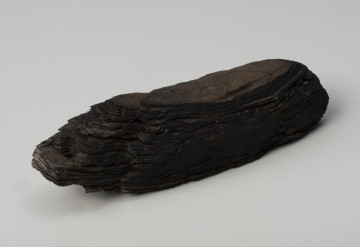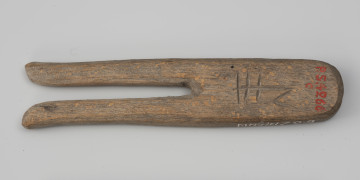
Net float
1201 — 1250
National Museum in Szczecin
Part of the collection: Middle Ages
Floats are one of the most commonly found fishing artefacts on archaeological sites in the immediate vicinity of bodies of water. They were most commonly made from bark of both deciduous and coniferous trees, a raw material with a very good ability to stay afloat. The bark was most readily harvested in spring or autumn, when it could easily be stripped from the tree. The shape of the floats themselves was made by planing with a knife, while the holes that were used to tie the ropes were drilled with the tip of a knife or an iron auger. The most common types of floats found in the archaeological material are oval, trapezoidal and circular forms. Floats were used to keep the net afloat and also made it easier to locate the net. They were also used as floats when fishing with a pole or floating rod. The presented float was discovered in 1962 during excavations carried out in Kamień Pomorski (West Pomeranian Voivodeship). It was made from a piece of conifer bark and is shaped like an irregular circle with a through hole in the middle. Grzegorz Durdyń
Author / creator
Object type
fishing net buoy
Technique
planing, drilling
Material
bark
Origin / acquisition method
field research
Creation time / dating
Creation / finding place
Owner
Muzeum Narodowe w Szczecinie
Identification number
Location / status

1201 — 1250
National Museum in Szczecin

1890 — 1950
National Museum in Szczecin

1940 — 1949
National Museum in Szczecin
DISCOVER this TOPIC
Museum of King Jan III's Palace at Wilanów
DISCOVER this PATH
Educational path